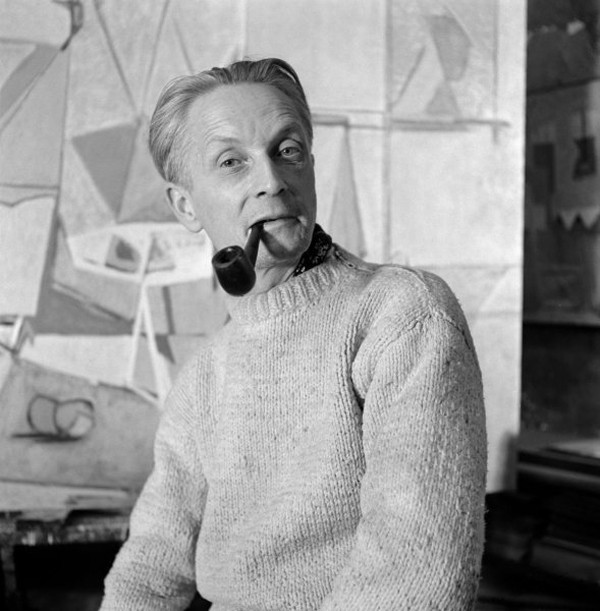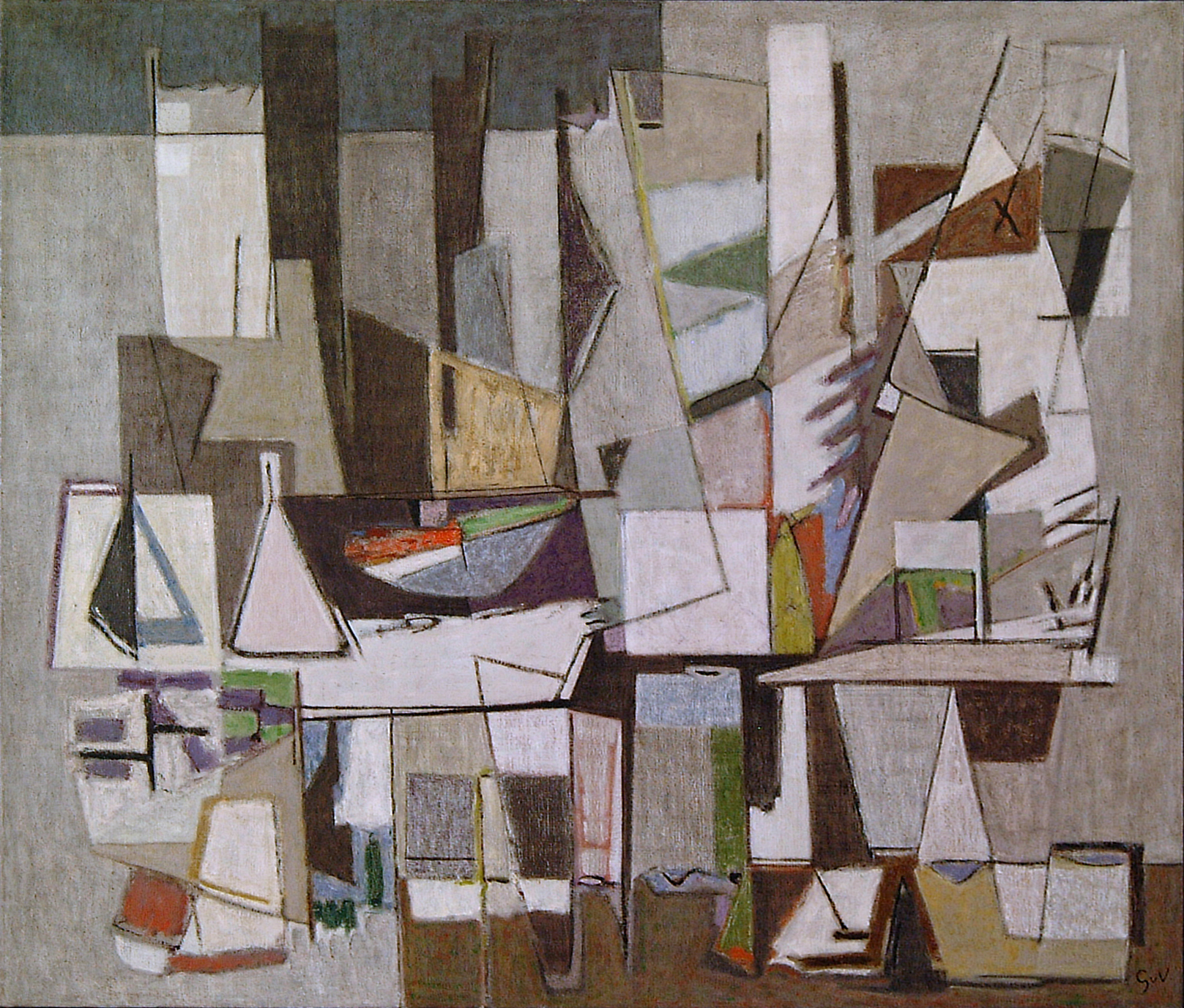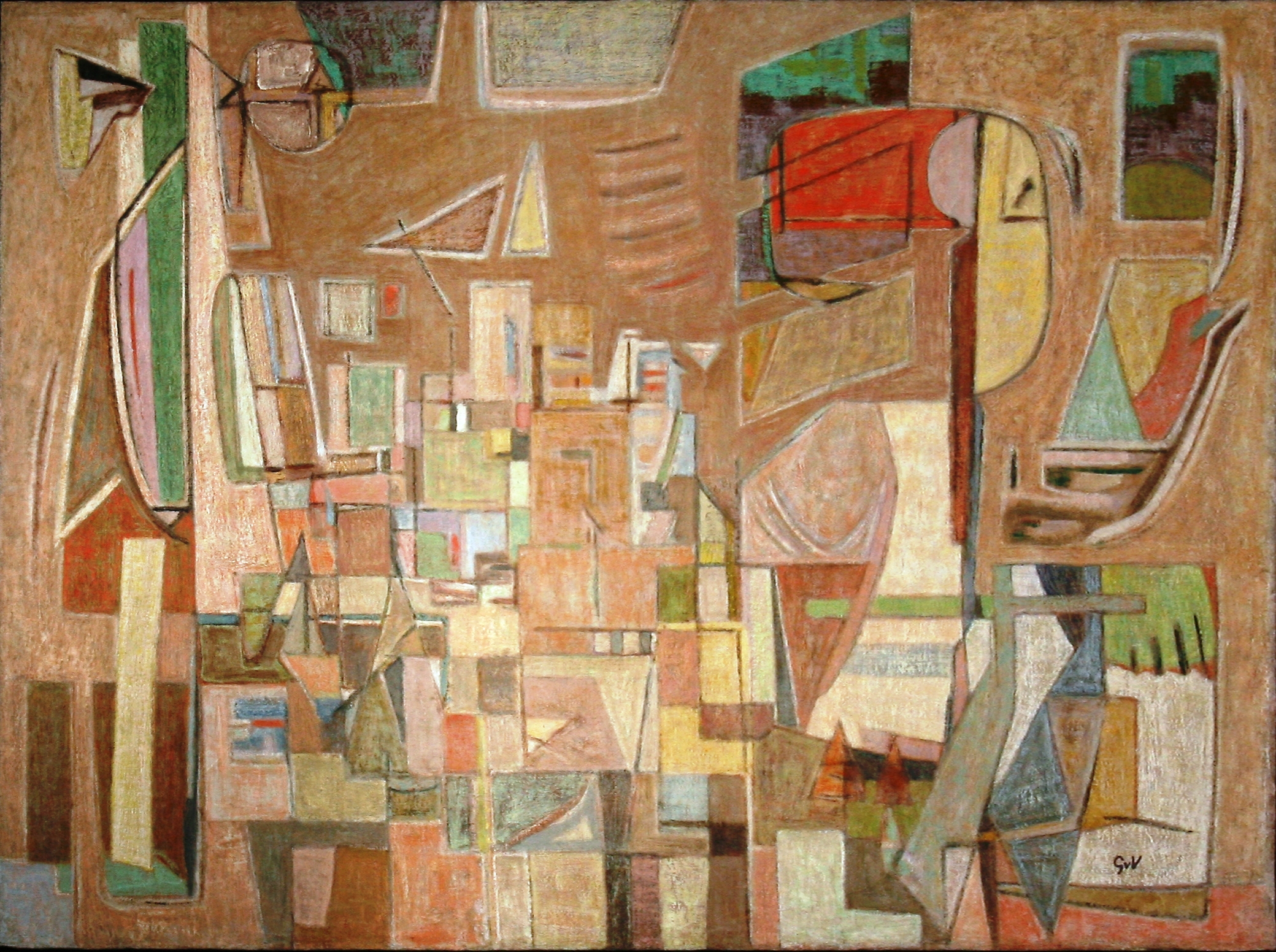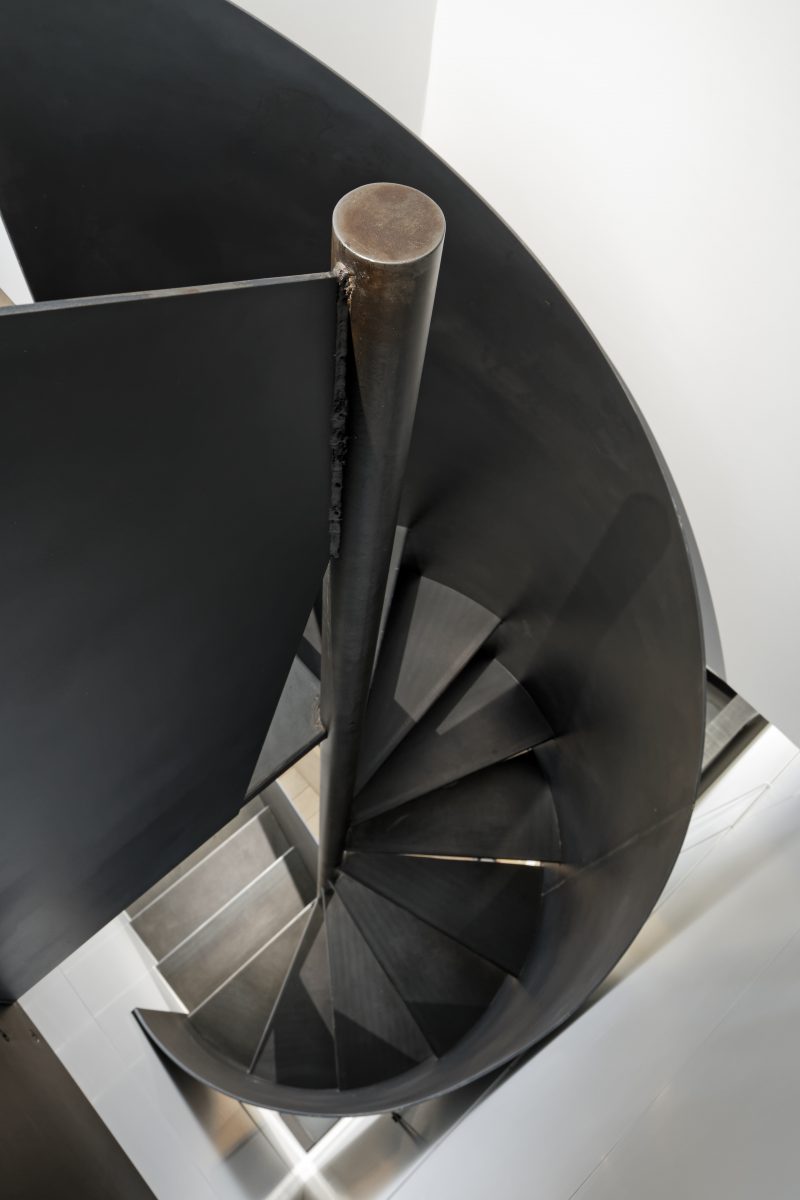After the exhibition, Samuel Beckett wrote a study on La peinture des Van Velde, ou le monde et le pantalon (Cahiers d’Art, 1945–1946). In his presentation of Geer’s works he refers to “painting that is extraordinarily calm and gentle”. In June 1948 Beckett wrote another text for Geer’s second exhibition, this time held with Bram: Peintres de l’empêchement, and Jacques Kober wrote Autant parler du silence. (Derrière le miroir, no. 11–12, Galerie Maeght). Geer and Bram showed at the Kootz Gallery in New York through the intermediary of Maeght. Around this time the artist told Bernard Dorival: “The eye does not have all the rights; it must leave something to intuition and intelligence. I tend increasingly towards lyricism” (Les étapes de la peinture française contemporaine, Gallimard, 1946). Geer participated in group exhibitions at the Galerie Maeght: from 1946 to 1947 with Le noir est une couleur (Derrière le miroir no. 1, text by Jacques Kober, with six lithographs by Geer Van Velde), and in 1947 with Sur 4 murs (Derrière le miroir no. 2, texts by Michel Seuphor and René Guilly).
We should recall the various journeys that Geer made to Holland in the years following the war, when he was influenced by the rigorous structure characteristic of Dutch landscapes. He was also strongly influenced by the Mondrian retrospective held in Amsterdam in 1946.
In November 1952 his last solo exhibition was held at the Galerie Maeght, with a catalogue with texts by Roger Chastel: Devant le miroir, and Frank Elgar’s Geer Van Velde (Derrière le miroir no. 51 with two coloured lithographs). Like it had been for Bram, the event was a commercial failure. Both brothers distanced themselves from the gallery, each from now on following their own solitary path.
Never abstract, Geer’s work, with its subtle, sometimes monochrome colours, resembles a long meditation on light. Indescribable movements underline intermediary spaces, the plastic equivalents of which are a linear architecture that gradually gives way to suggest depth.
Without ever attaining Mondrian’s radicalism, Geer separates the chromatic surfaces, cut into segments, from the background to liberate “the essential which is not what is visible but our inner world”. Vertical lines surround an empty central area defining the picture space. Gradually these lines disappear, replaced by a square, in its turn divided into four. Planes and colours are distributed from this centre, luminous or dark surfaces underlined by light brush strokes and gouache stains, or by a few lines in charcoal or chalk. Piet Moget, an artist friend, recounted the way in which Geer worked, following his own explanations: “The artist prepared his canvas himself. He needed a plain background, which would absorb… he drew the main rhythms and masses in charcoal, then covered the entire surface of the canvas with a thin coat of zinc white with oil applied very dry without thinner. The charcoal lines remained just visible. He then stuck on newspapers to absorb the oil… He hated a slippery canvas” (Catalogue Rétrospective, Ville de Paris, 1982). Geer remained faithful to this technique.
Geer had few exhibitions. He did not show again in Paris until 1966, when he had an exhibition at the Musée Galliéra with a catalogue text by R.V. Gindertaël. In 1972 he had an exhibition at the Château de Ratilly, with texts by Gaëtan Picon, A.H. Hammacher, R.V. Gindertaël, Michel Seuphor and Charles Estienne. (List in the monograph by Germain Viatte.)
Among the group exhibitions: 1946 Matisse, Marchand, Chastel, Van Velde, Galerie Maeght, Cannes. 1947 Peintres d’aujourd’hui, Galerie Ruhl, Nice. 1949 De la figuration à l’abstraction, Museum of Modern Art, São Paulo. 1950 De Manet hasta nuestros dias, Montevideo, Caracas, Lima; Levende Farver, Charlottenborg, Denmark. 1951 first Biennale de Menton, at which he received the first prize for a foreign artist; L’École de Paris 1900–1950, Royal Academy of Arts, London. 1952 Rythmes et couleurs, Musée Lausanne; Drei Künstler ans Paris: Geer Van Velde, Morice Lipsi, Ismaël de la Serna, Recklinghausen, catalogue; Malerei in Paris heute, Kunsthaus, Zurich; Tendances actuelles de l’École de Paris, Kunsthalle, Berne. 1953 Elf tijdgenoten vit Paris, Stedelijk Museum, Amsterdam. 1955 Peintres de l’École de Paris, Varsberg, Sweden, Catalogue. 1958 Nouvelle École de Paris, Kunsthalle, Mannheim. 1959 Malarstwo Francuske od Gauguina dodnia Dzisiejszego, Naradowe Museum, Warsaw. 1961 Pittori d’Oggi Francia-Italia, Turin. 1962 École de Paris, Tate Gallery, London. 1963 Cien Anos de Pintura en Francia, Caracas.
He participated annually in the Salon de Mai from 1949 to 1971, as well as selections for Amsterdam in 1961 and Tokyo in 1963. He also took part in the Réalités Nouvelles, and in the Grands et jeunes d’aujourd’hui. He was invited to participate in École de Paris at the Galerie Charpentier in 1954, 1959 and 1960.
1982 Paintings and works on paper. Musée d’Art Moderne de la Ville de Paris. Catalogue, texts by Samuel Beckett, A.M. Hammacher, Piet Moget Ma rencontre avec Geer Van Velde.
1982 Peintures. Galerie Louis Carré et Cie, Paris. Catalogue text by Marcelin Pleynet.
1986 Geer Van Velde. Musée Toulouse-Lautrec, Albi. Catalogue.
1989 Œuvres sur papier. Galerie Louis Carré et Cie, Paris.
1991 Drawings. Collection acquired in 1983 by the state. Musée National d’Art Moderne, Centre Georges Pompidou, Paris.
1991 Rétrospective. Lieu d’Art Contemporain Sigean (Aude) Catalogue, text by Piet Moget.
Museums: Paris, National d’Art Moderne and d’Art Moderne de la Ville (important collection).
- Germain Viatte: Geer Van Velde. Cahiers d’Art, 1989; includes key texts and prefaces.



